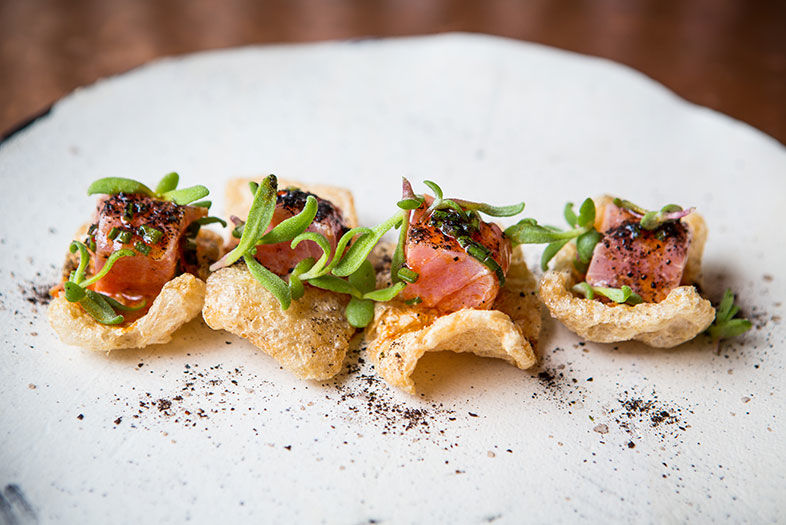Tostadas are essentially tacos somebody chose not to fold. Like half-assed laundry. Eating them is similar to eating a pizza, except there’s a high probability with every bite that the crust might explode and rain food shrapnel on your person. Wear your plastic shirt.
Tostadas are also the hottest thing at Común [ko-MOON] Kitchen and Tavern, the new East Village restaurant from chef Chad White. Why tostadas? Because of San Diego’s taco glut, I’d imagine. Opening another taco place here now would be like opening a pizza joint in Manhattan. So the talented and creative White decided to go with the half-assed laundry taco.
We eat three on Tuesday, when tostadas are only $3 a piece and Común goes through more of them than Hooters does chicken wings. We eat them extraordinarily carefully, as dictated by tostada law. Común’s corn-shell plate is one of the greatest I’ve ever tasted—extraordinarily crispy and flavorful. The toppings, however, are surprisingly pedestrian. None are bad. White can really cook, after all. They’re just kind of elemental, unsurprising, and homey. They also lack the bright, fresh ingredients almost required of restaurants located in Southern California’s produce-apalooza.
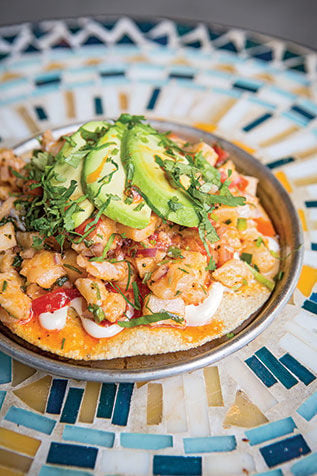
Restaurant Review: Común
Ceviche tostada with yellowtail, tomato, cilantro, jalapeño, red onion, avocado, and lime
Of the three, the ceviche is a standout, with yellowtail, tomato, cilantro, jalapeño, red onion, avocado, and lime. It’s wet with chile oil, which is a welcome bit of spicy fat. That same fat content is a problem on our other tostadas. The beef heart tartare is essentially “Fat, Four Ways,” with dollops of mayo, chile oil, avocado, and the traditional tartare egg yolk.
Dehydrated spring onions have a fantastic herbal sweetness, but, unlike fresh onions, they don’t have the acidic zing to cut the fat. The carnitas tostada with smoked orange marmalade is flavorful and tender, but it’s mostly a pile of sweetened, slow-cooked meat with cilantro, onion, and avocado. When a chef of White’s caliber is doing tostadas, I guess I expect more. I want freaky sauces, innovative fixings—a well-juxtaposed bonanza of creative edibles that really elevates the common street food and makes it a Chad White Half-Assed Laundry Taco!™ If he needs to charge more than $3, I’ll gladly pay for it.
Be sure to ask for Común’s hot sauces and salsas. No server offered them, but they have three versions, including a habanero number that could make divorce papers taste great.
White is, well, white. A backwater part of me wants to discount his Mexican food efforts due to ethnic trespassing. You know, say something skeptical about “authenticity.” But that part of me would be wrong. At this point food is a global pursuit, an alluvial fan of cultures. To get technically historical, almost every food is Chinese food. And White has deeper Mexican roots than most. He married into the culture. He traveled for a long stretch of time through Baja with its top chefs. He co-owns a “gastro bar” in Tijuana called La Justina. He’s worked with Tijuana’s culinary institute, and now lives in Tijuana. If he didn’t open a gringo-Mex restaurant at this point, it’d be silly.
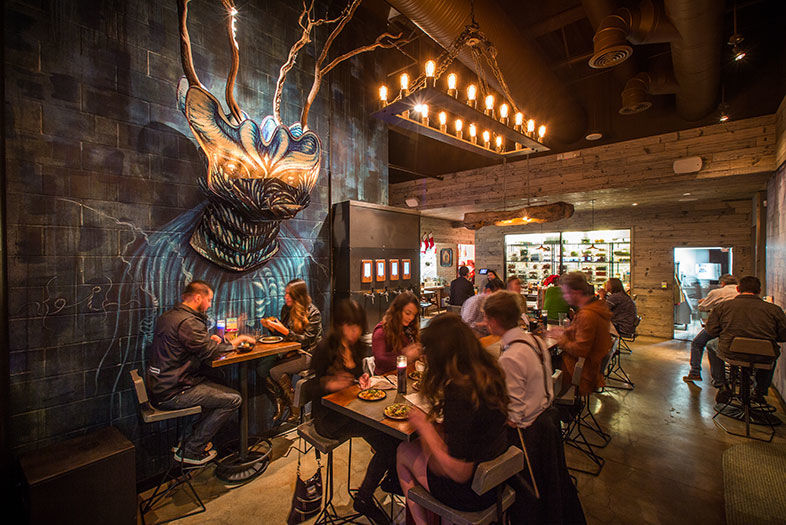
Restaurant Review: Común
Común is tucked on J Street along the stretch of bottom-floor retail on the northeast corner of Petco Park, downtown. Foot traffic often stays four blocks west in the Gaslamp, or congregates at Basic pizzeria across the street. As the economy makes its comeback tour, there is renewed promise on this block, and Común is part of it.
The décor is well done, and what you might expect of a hip restaurant circa 2015. A succulent plant wall. A community table. A chandelier made of a reclaimed log. Aluminum siding. Edison bulbs. Local artist Gloria Muriel created two massive statement pieces. The tiny kitchen is wide open. The bathrooms smell amazing (seriously—it’s just a really strong candle, but it makes a huge, pleasant difference). There are glass religious candles on each table. A wall of self-serve craft beer with digital descriptions of each is either innovative, gimmicky, or a little of both (you get a bracelet, hold it up to the tap, it dispenses; you pay when you’ve had your fill). The paper napkins scream “street food,” but even a humble dishrag would be better than a wad of used paper on the table.
From the snacks part of the menu, the chicharrón is great, a curl of puffy-fried pigskin cradling a chunk of albacore belly that’s wet with sesame oil, lime, and ash (a signature of Baja cooking). White’s Brussels sprouts are addictively good, fried and tossed with Caesar dressing, Romano cheese, and breadcrumbs. That Caesar dressing also makes the baby kale salad pretty dreamy, with Pecorino, slices of Brussels sprouts, and Morita ash crumbs. His radish appetizer, though, is odd. It is simply raw radishes with a touch of sea salt, served with a dollop of coriander aioli. Radishes are a common Mexican snack, especially in Oaxaca. And while I can appreciate nods to tradition and minimalism, I can wash, rinse, and salt raw produce at home. The street corn (elotes), too, falls short. Without enough cream, it tastes like some meddling nutritionist got ahold of my street food. Healthy elotes are like diet donuts: perverse and unnatural.
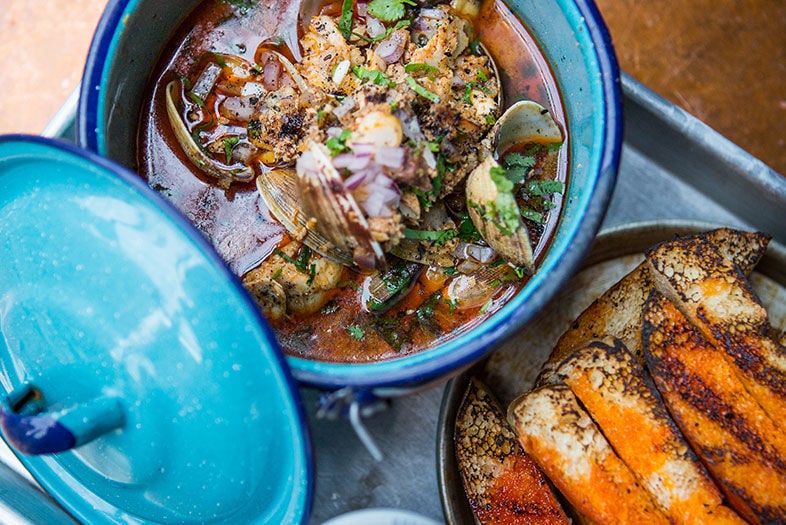
Restaurant Review: Común
Mexican beer, Baja clams, smoked mahi mahi and chorizo jus, hominy, red onion, cilantro, grilled bread
Mexican beer, Baja clams, smoked mahi mahi and chorizo jus, hominy, red onion, cilantro, grilled bread
Service is laid-back, almost excessively. During two dinner visits our servers act like genuine, comfortable, no-B.S. friends. Easy people to like. Unfortunately, one is a tad short on information, and the other is a little distracted. Radishes, for example, are a rare restaurant dish. Servers should probably explain to newbies that raw produce will be served. I ask one server for a good mocktail. He seems stumped. I clarify, “You know, maybe some soda water with muddled berries and mint and a little simple syrup.” I am served a glass with un-muddled strawberries and mint floating on top—an excessively garnished soda water. I should’ve just ordered one of the Baja wines.
At lunch, White serves bowls of organic brown rice (or baby kale) with seasoned meats. The grilled Jidori chicken with okra, hominy, arugula, and pepper vinaigrette is very good, with the okra cooked to the perfect pre-slime edge. With the steak-and-mushrooms, the meat is cooked and seasoned nicely with chile ash. But the mushrooms and fingerling potatoes are a touch bland, and the whole affair needs a sauce beyond olive oil. The potatoes might be cut to max out the caramelize-able surface area. That said, White’s managed to create the unicorn of Mexican food: a “light lunch.”
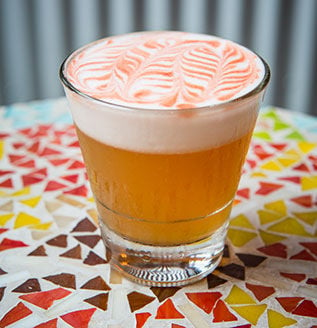
Restaurant Review: Común
Lafayette Sour: spiced bourbon, lemon, demerara sugar, egg white
For dinner entrees, definitely try the beef sirloin with hominy puree and sour cherry preserve salsa. They might dial the sweetness of the puree back just a touch to hit perfection, but it’s very good. The roasted lamb leg with pinto beans, chorizo, and bacon is nice, not phenomenal. It’s almost like a reduced stew. Served with corn tortillas, it needs an innovative crème fraîche or a side of herbs and produce (like the Vietnamese do with pho). The jus of the steamed fish dish (Baja clams, smoked mahi mahi) tastes largely the same as the lamb, due to the unmistakable chorizo. It’s served with the few remaining ounces of Modelo beer, a fun touch. As for the roasted rockfish with garlic, butter, chile guerro, green onion, shrimp, pickles and baby arugula—it’s bad. Not badly cooked—in fact, all the supporting flavors of the dish are excellent. The fish itself is exceedingly fishy, which usually means it’s old.
For dessert, the tres leches is not a cake as much as a sweetened roll (concha), bruléed on top, with a delicious star anise crema. The inside of the roll is too dry and airy, though. An integral part of tres leches’ charm is that wet cake, sopped with cream. The cajeta choco flan with chipotle peanut brittle and smoked orange marmalade also has issues in breaking with tradition. It’s served in a metal mug. The beauty of flan comes from its perfect, self-contained jiggle. This is more like a giant pot de crème topped with cake crumbles.
White is a talented chef who gives a damn about both Mexican culture and food culture. Aside from the rockfish, we didn’t have a bad bite at Común. It’s nice Mexican street food, with a fresher, healthier spin. Yet everything feels safe, a little unremarkable—almost as if created to win over middle-America palates hesitant to eat half-assed laundry tacos, instead of truly exciting the San Diego food natives hungry to see what White can do.
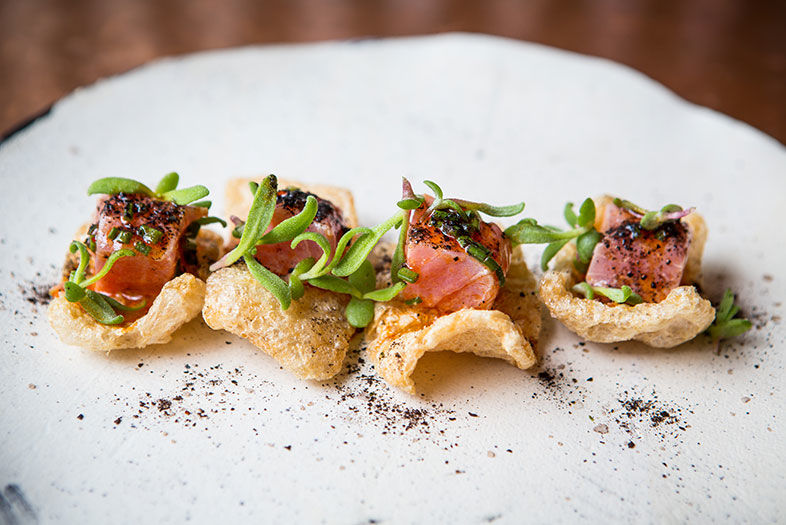
Restaurant Review: Común
PARTNER CONTENT
Chicharrón with albacore belly, sesame oil, lime, and ash














